Arch Coal, Inc. Reports Full Year 2008 Results
Company delivers best year on record for earnings per share;
EBITDA expands 60% versus a year ago;
Record operating cash flow more than doubles versus 2007
ST. LOUIS (January 30, 2009) - Arch Coal, Inc. (NYSE: ACI) today reported record net income of $354.3 million, or $2.45 per fully diluted share, in 2008 compared with $174.9 million, or $1.21 per fully diluted share, in 2007. Over the same time period, income from operations doubled to $460.4 million and adjusted EBITDA grew 60 percent to reach $753.2 million. Revenues rose nearly 24 percent versus a year ago while sales volume grew 4 percent. The company also generated a record $679.1 million in operating cash flow in 2008, doubling the prior year level.
"Arch achieved its best performance on record in 2008 as measured by several metrics," said Steven F. Leer, Arch's chairman and chief executive officer. "We delivered an exceptional financial performance, attaining substantial growth in earnings and cash flow. We also completed our best year on record for safety performance and environmental stewardship. We commend our employees for their contributions to an outstanding 2008."
In the fourth quarter of 2008, Arch reported net income of $62.3 million, or $0.44 per fully diluted share, compared with $81.4 million, or $0.56 per fully diluted share, in the prior-year quarter. Net income and earnings per share in the fourth quarter of 2007 benefited from a $35 million reduction in the company's valuation allowance for deferred tax assets.
Fourth quarter 2008 income from operations increased 16 percent to reach $87.2 million, and adjusted EBITDA grew 14 percent to $162.9 million, when compared with the prior-year period. The company benefited from an excise tax refund of $19.6 million recorded in the fourth quarter of 2008, half of which is reported as interest income.
"We are proud of the record earnings achieved in 2008, but are approaching 2009 with a cautious view of the current global and domestic economic challenges," said Leer. "We are taking specific actions to address such challenges. In 2009, Arch is reducing production and capital spending levels in light of weaker economic and near-term coal market trends, while taking steps to further enhance its strong balance sheet. We also remain passionately focused on controlling costs and on preserving flexibility to respond to changing market conditions."
"Arch is committed to making sound business decisions today to retain upside potential in future periods," added Leer. "This strategy is driven by our positive intermediate and long-term outlook for coal markets. We have strategically positioned the company to succeed through the whole market cycle - and we expect that the current economic climate will present attractive opportunities for Arch to further strengthen its competitive position within the global coal industry. We remain dedicated to creating long-term value for Arch's shareholders, and fully expect to emerge from this economic downturn as an even stronger market-driven company."
Arch Maintains Strong Balance Sheet; Takes Steps to Enhance Shareholder Value in 2008
Arch improved its debt-to-total capital ratio in 2008, ending the year at 43 percent compared with 46 percent at the end of 2007. Also, the company had roughly $712 million of committed total liquidity, comprised of $71 million in cash and approximately $641 million available to be borrowed under its bank facility and accounts receivable securitization program, at December 31, 2008.
During the third quarter of 2008, Arch repurchased 1.5 million shares of its outstanding common stock. The company also announced a $0.02 per share increase in the dividend on its common stock in April 2008.
"We continue to strengthen our balance sheet by reducing our leverage ratio, increasing cash on hand and improving our liquidity position," said John T. Drexler, Arch's senior vice president and chief financial officer. "We are comfortable that Arch is in a sound financial position to weather the current economic downturn. We also returned cash to shareholders in 2008, via repurchases and dividends, funded from our record cash flow from operations."
Arch Advances Core Values
Arch's 2008 safety record surpassed the company's previous best-in-class performances. Arch's lost-time incident rate declined more than 20 percent from 2007 - to 0.81 incidents per 200,000 hours worked - again ranking Arch first among its major U.S. coal industry peers. The 2008 national coal industry average was nearly four times higher. The company also earned four national Sentinels of Safety certificates from the U.S. Department of Labor and six state awards for safety achievements within the past year.
Arch also excelled in environmental stewardship during 2008, achieving its best year on record for compliance and again leading its major U.S. coal industry peers. Arch subsidiaries earned two national Good Neighbor Awards from the U.S. Department of Interior and received six state awards for excellence in land reclamation, wildlife habitat enhancement and community service in the past year.
"Our accomplishments are significant and underscore Arch's dedication to continuous improvement in safety and environmental performance," said Leer. "At the same time, our goal is to achieve a Perfect Zero in safety incidents and environmental violations at every one of our mines, every single year."
Also during the fourth quarter, Arch pledged up to $6.5 million in funding for university research projects geared towards the advancement of clean coal technologies, including carbon capture and storage solutions. Arch joins a consortium of companies across industries in the private sector along with governmental organizations and academia in funding these projects to ensure a more secure and sustainable energy future.
"Global coal consumption has risen 40 percent in the past seven years - with the majority of this growth from emerging economies," said Leer. "We believe it is essential to increase investments in technologies that continue to make coal use in this country and around the world cleaner, more efficient and more climate friendly."
A Record Operational Performance Caps 2008
"Our operations ran well in the fourth quarter, and turned in an outstanding performance for full year 2008," said John W. Eaves, Arch's president and chief operating officer. "Each operating region made a contribution to our results, particularly Central Appalachia where per-ton operating margins increased more than fourfold."
"Looking ahead, we expect our 2009 cost structure to be impacted by lower targeted production levels, higher diesel costs associated with hedges established in 2008 as well as challenges in transitioning to a new coal seam at our mine in Colorado during the first quarter," continued Eaves. "At the same time, our operations represent some of the most cost competitive assets in the U.S. coal industry, and we will exercise significant cost and capital spending control during this weak market cycle."
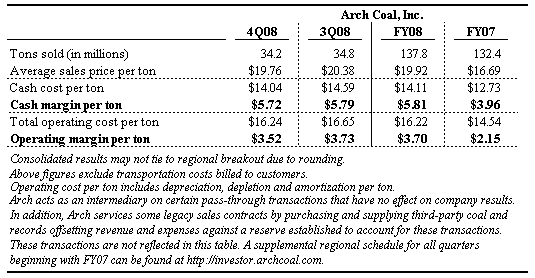
Consolidated average sales price per ton declined $0.62 in the fourth quarter of 2008 when compared with the third quarter, primarily reflecting lower price realizations in Central Appalachia. Consolidated per-ton operating costs decreased $0.41 over the same time period, driven by lower operating costs in each of the company's segments. Arch earned $3.52 per ton in consolidated operating margin in the fourth quarter of 2008 compared with $3.73 per ton in the prior-quarter period.
Consolidated 2008 sales volume increased 4 percent, reflecting higher volume levels across Arch's operating regions. Average sales price per ton rose $3.23 in 2008, reflecting price improvement in each of the company's segments, particularly Central Appalachia. Consolidated per-ton operating costs rose by $1.68 over the same time frame, driven by higher sales sensitive costs and increased commodity and input cost pressures. In 2008, Arch earned $3.70 per ton in consolidated operating margin, a 72 percent improvement from 2007.
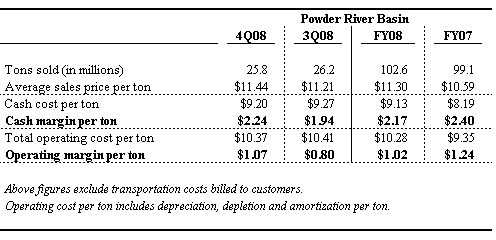
In the Powder River Basin, fourth quarter 2008 volumes declined slightly from the prior-quarter period, as the company idled equipment during the fourth quarter. Average sales price per ton increased $0.23 when compared with the third quarter, reflecting a more favorable mix of customer shipments. Per-ton operating costs declined modestly over this same time period, despite reduced volumes, contributing to the expansion of the region's per-ton operating margin.
Full year 2008 volumes increased modestly, while average sales price per ton rose by nearly 7 percent from 2007, driven by strong market conditions during the first half of 2008. Per-ton operating costs increased 10 percent over the same time period due to higher commodity and sales sensitive costs in the region. Arch's Powder River Basin operations contributed $1.02 per ton in operating margin in 2008 compared with $1.24 per ton in 2007.
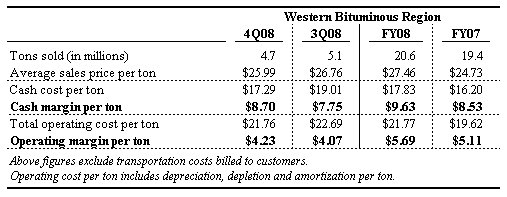
In the Western Bituminous region, fourth quarter 2008 volumes were impacted by the transition to the new coal seam at Arch's West Elk mine and the start-up of a new longwall at that complex in December 2008. Fourth quarter 2008 average sales price per ton declined $0.77 when compared with the third quarter due to a less favorable mix of customer shipments and reduced coal quality from the E-seam transition. Operating costs decreased $0.93 per ton over the same time period, reflecting lower sales-sensitive costs and one fewer longwall move, which helped to modestly expand operating margin per ton.
Beginning in December 2008, West Elk encountered difficult geologic conditions as the longwall began operations in the new coal seam, which has slowed mining and is impacting coal quality shipped from the complex. Additionally, the mine experienced a roof fall that temporarily halted production for 10 days in January. While conditions are expected to improve as the longwall progresses in its current panel, the transition costs, lower production levels and adverse mining conditions are likely to materially impact the first quarter of 2009.
Full year 2008 volumes increased 1.2 million tons versus the prior year, benefiting from increased shipments at Arch's Utah operations. Average 2008 sales price per ton increased $2.73 from 2007, reflecting the roll-off of lower-priced sales contracts and increased open market sales during the year. Per-ton operating costs rose by $2.15 over the same time frame, driven by higher sales sensitive and input costs as well as higher depreciation, depletion and amortization expense. Arch's Western Bituminous operations contributed $5.69 per ton in operating margin in 2008, an 11 percent improvement from 2007.
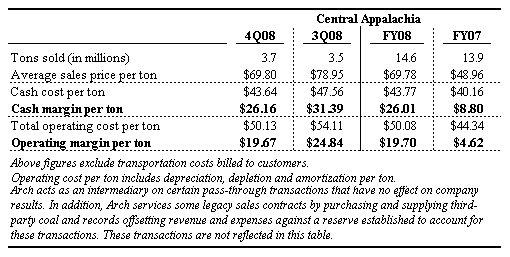
In Central Appalachia, Arch's fourth quarter 2008 volumes increased slightly, while average sales price per ton declined 12 percent when compared with the third quarter. Lower per-ton price realizations reflect a smaller percentage of metallurgical coal shipments in the fourth quarter. Per-ton operating costs decreased 7 percent over the same time period, benefiting from the aforementioned excise tax refund as well as lower sales-sensitive costs in the fourth quarter. Arch's Central Appalachian operations contributed $19.67 per ton in operating margin during the fourth quarter of 2008 compared with $24.84 per ton in the prior-quarter period.
Volumes in Central Appalachia increased 5 percent in 2008 versus 2007, reflecting a full year contribution from the Mountain Laurel complex. Average sales price per ton climbed 43 percent over the same time period, benefiting from strong metallurgical and steam market conditions in 2008, particularly in the first half of the year. Per-ton operating costs grew by 13 percent versus 2007, driven by higher sales-sensitive costs and depreciation, depletion and amortization expense. Operating margins in Arch's Central Appalachian region more than quadrupled from the prior year to reach $19.70 per ton in 2008.
Arch Completes 2008 Capital Projects; Targets Lower Spending Levels in 2009
During the fourth quarter of 2008, Arch completed the construction and placed into service a new, state-of-the-art loadout at the company's Black Thunder complex in the Powder River Basin. At a cost of roughly $120 million, the West Loadout took three years to design and build. As previously announced in the fourth quarter of 2005, Arch sold its lower capacity South Loadout, rail spur and an idle office complex to Peabody Energy, who took full possession of these facilities on December 31, 2008.
Arch also neared completion of the E-Seam transition at West Elk during the fourth quarter of 2008. This transition allows West Elk to continue production of a high-Btu, low-sulfur product in the Western Bituminous region. The project included four years of permitting, at least 50 months of development work and more than $200 million in capital to provide new and extended mine infrastructure, including a new longwall, high-capacity belt conveying systems, an underground coal bunker and an enhanced ventilation system.
With the nearly unprecedented turmoil in U.S. financial markets and the large degree of uncertainty in the U.S. and world economies, Arch is proactively electing to reduce its discretionary capital spending in 2009. The company expects to spend between $215 million and $245 million for maintenance capital, with an additional $40 million for previously committed projects - primarily related to West Elk - that will be completed in the first quarter of 2009. Arch also expects to spend $155 million to $185 million for land and reserve additions in 2009.
"Arch continues to forecast a very attractive long-term outlook for global coal markets," said Leer. "At the same time, we believe it is prudent to align capital spending with current soft market conditions and economic uncertainty."
Arch Expects a Weaker Coal Market in 2009 to Lead to Better Balance in 2010
Coal markets weakened during the second half of 2008 as milder weather, high generator coal stockpile levels, slowing economic activity and declining prices for competing fuels caused deterioration in coal pricing from record levels experienced earlier in the year.
Arch estimates that U.S. power generation declined 0.9 percent in 2008 - consistent with a recessionary economy - while overall coal consumption increased 1.1 percent. The growth in coal demand was driven by increased U.S. metallurgical and steam coal exports in 2008, which more than offset the slight decline in consumption for power generation. Arch estimates that generators ended the year with a 59-day supply of coal in stockpiles compared with 53 days at the end of 2007.
In 2009, Arch forecasts power generation to decline more than 1 percent due to a weaker U.S. and global economy. The company also expects U.S. coal consumption to decline this year, stemming from reduced consumption for power generation, lower metallurgical coal exports given global steel production cuts as well as the potential for some fuel switching to natural gas given current depressed natural gas prices. As a result of near-term market pressures, Arch believes coal production and capital spending levels industry-wide will be curtailed - driven by geologic challenges, cost pressures, regulatory hurdles and lack of access to capital.
Additionally, Arch now forecasts that 16.5 gigawatts of new coal-fueled capacity are under construction in the United States, equating to at least 56 million tons of new coal demand on an annual basis. These plants are forecasted to come online during the next four years, with two-thirds of that capacity online by the end of 2010.
"We believe that 2009 will be a transitional year for the U.S. coal industry," said Leer. "Supply rationalization coupled with the re-start of global economic activity later in the year and demand from new coal plants coming online should cause markets to rebalance over time."
"Over the intermediate and long-term, Arch believes coal market fundamentals are very favorable, benefiting from a secular up-trend in energy use," added Leer. "Coal has been the fastest growing fuel source on the planet since 2000 - and will likely continue to grow rapidly as developing economies, in particular, embrace this affordable, abundant and indigenous resource for power generation. In addition, supply constraints in major coal exporting countries remain in place, helping to attract customers to U.S. coal for purposes of supply diversification. Lastly, a return to normal steel production rates will benefit metallurgical coal consumption, which remains a scarce global commodity."
Arch Lowers Production Levels in 2009; Reaches Agreement for Increased Sales to Asia
Given the current weakness in U.S. coal markets, Arch has reduced its production targets in 2009. The company projects sales volumes from company-controlled operations of between 120 million and 127 million tons for the full year. Included in this range are 6 million tons of metallurgical quality coal - some of which will likely shift into steam coal markets or, conversely, will be left in the ground depending on market conditions.
"We are confident that a patient, market-driven approach to sales contracting and the commitment to leave tons in the ground are the right long-term decisions for the company and our shareholders," said Leer. "We will preserve the value of our low-cost reserves for the future when market conditions improve. We strongly believe that our market-driven strategy allows Arch to be successful during market troughs and to excel during market peaks."
In the fourth quarter of 2008, Arch signed sales agreements for an aggregate 20 million tons of Powder River Basin coal for ratable delivery in 2009 through 2011, at more than a 40 percent weighted average price premium to the company's fourth quarter 2008 average realized price in the region. Arch also reached agreement with Chinese and Indian customers to deliver approximately 2 million tons of coal in 2009 via the west coast of Canada, at average netback mine prices comparable to current prevailing domestic prices in the region.
"Even in this challenging market environment, we are making real progress in expanding Arch's market penetration in the Asia-Pacific Rim," said Eaves. "We believe these developments are significant - and set the stage for increased participation when global economic growth resumes."
Also during the fourth quarter, Arch committed roughly 2 million tons of Central Appalachian coal into metallurgical and steam coal markets for 2009 delivery, at average prices that exceeded the company's fourth quarter 2008 average realized price in the region.
With reduced volume targets and the signing of selective contracts during the fourth quarter of 2008, Arch now has unpriced coal volumes of between 14 million and 18 million tons in 2009, half of which is already committed but not yet priced. Based on the company's current lower production levels, Arch has unpriced volumes of between 55 million and 65 million tons in 2010 and between 95 million and 105 million tons in 2011.
Arch Maintains Cautious Outlook in 2009
"It is extremely difficult to forecast 2009 with any precision at this time due to the current state of flux in the economy and in global steam and metallurgical coal markets," said Leer. "As such, Arch is adopting a cautious approach to 2009 and has elected against attempts to project earnings per share or EBITDA at this time."
For 2009, Arch projects the following:
- As previously stated, sales volume from company controlled operations is expected to be between 120 million and 127 million tons, excluding all purchased coal from third parties.
- Total capital spending is projected to range from $255 million to $285 million, excluding reserve additions.
- Depreciation, depletion and amortization expense is expected to be in the $300 million to $310 million range.
Arch expects the first quarter of 2009 to be the weakest operating period of the year - and substantially below the fourth quarter of 2008 - given the challenges already experienced at West Elk.
"We are in a very strong position to weather the near-term economic uncertainty," added Leer. "Although there currently is a lack of clarity in the market, Arch continues to benefit from its relatively low level of debt and its even lower level of legacy liabilities. Our solid cash position and strong liquidity levels will allow the company to actively evaluate value-creating acquisition opportunities in the current environment. And, over the entire market cycle, we believe Arch's size, low-cost and diversified operational platform, extensive reserve base and talented workforce will enable the company to capitalize on future internal and external growth opportunities."
A conference call regarding Arch Coal's fourth quarter 2008 financial results will be webcast live today at 11 a.m. E.S.T. The conference call can be accessed via the "investor" section of the Arch Coal Web site (www.archcoal.com).
St. Louis-based Arch Coal is one of the largest U.S. coal producers, with revenues of $3.0 billion in 2008. Through its national network of mines, Arch supplies cleaner-burning, low-sulfur coal to fuel roughly 6 percent of the nation's electricity. The company also ships coal to domestic and international steel manufacturers as well as international power producers.
Forward-Looking Statements: This press release contains "forward-looking statements" - that is, statements related to future, not past, events. In this context, forward-looking statements often address our expected future business and financial performance, and often contain words such as "expects," "anticipates," "intends," "plans," "believes," "seeks," or "will." Forward-looking statements by their nature address matters that are, to different degrees, uncertain. For us, particular uncertainties arise from changes in the demand for our coal by the domestic electric generation industry; from legislation and regulations relating to the Clean Air Act and other environmental initiatives; from operational, geological, permit, labor and weather-related factors; from fluctuations in the amount of cash we generate from operations; from future integration of acquired businesses; and from numerous other matters of national, regional and global scale, including those of a political, economic, business, competitive or regulatory nature. These uncertainties may cause our actual future results to be materially different than those expressed in our forward-looking statements. We do not undertake to update our forward-looking statements, whether as a result of new information, future events or otherwise, except as may be required by law. For a description of some of the risks and uncertainties that may affect our future results, you should see the risk factors described from time to time in the reports we file with the Securities and Exchange Commission.
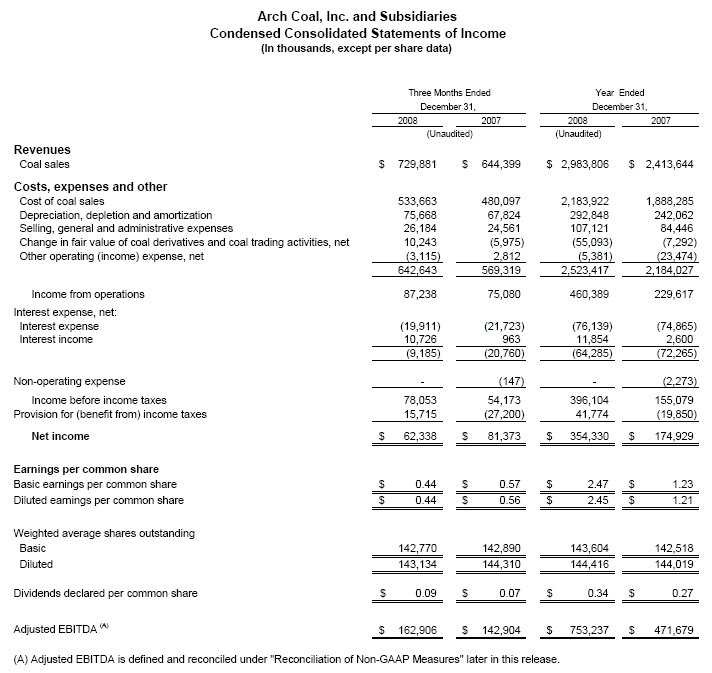
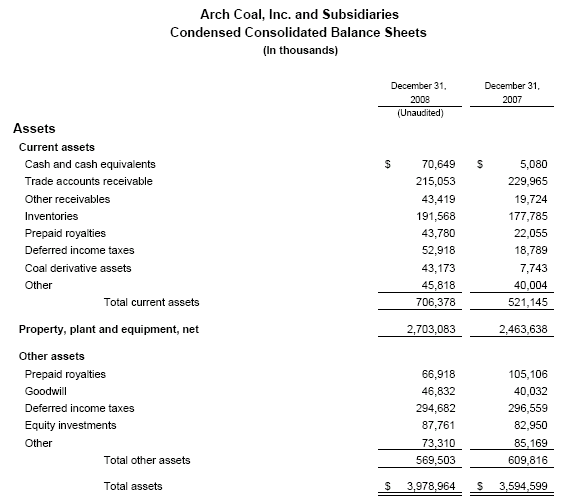
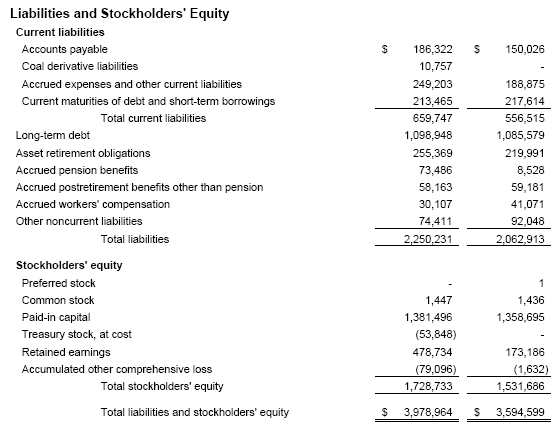
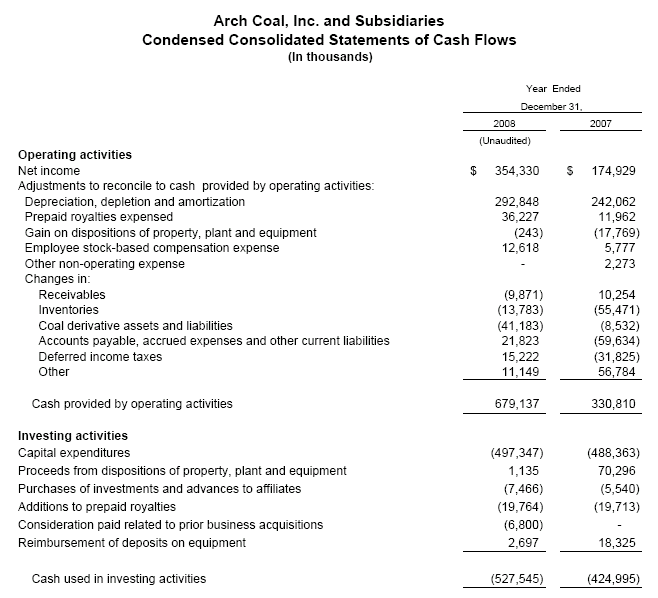
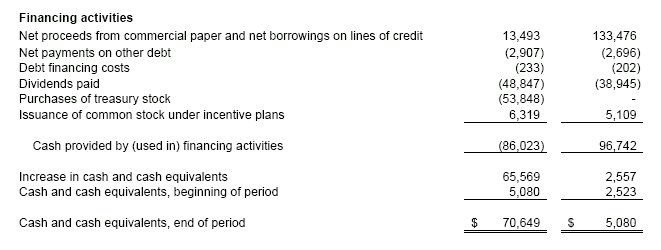
Arch Coal, Inc. and Subsidiaries
Reconciliation of Non-GAAP Measures
(In thousands)
Included in the accompanying release, we have disclosed certain non-GAAP measures as defined by Regulation G. The following reconciles these items to net income as reported under GAAP.
Adjusted EBITDA:
Adjusted EBITDA is defined as net income before the effect of net interest expense; income taxes; our depreciation, depletion and amortization; expenses resulting from early extinguishment of debt; and other non-operating expenses.
Adjusted EBITDA is not a measure of financial performance in accordance with generally accepted accounting principles, and items excluded to calculate Adjusted EBITDA are significant in understanding and assessing our financial condition. Therefore, Adjusted EBITDA should not be considered in isolation nor as an alternative to net income, income from operations, cash flows from operations or as a measure of our profitability, liquidity or performance under generally accepted accounting principles. We believe that Adjusted EBITDA presents a useful measure of our ability to service and incur debt based on ongoing operations. Furthermore, analogous measures are used by industry analysts to evaluate operating performance. Investors should be aware that our presentation of Adjusted EBITDA may not be comparable to similarly titled measures used by other companies. The table below shows how we calculate Adjusted EBITDA.
